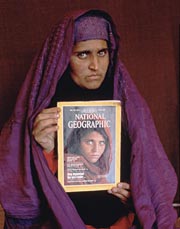
August 9, 2010 cover of Time Magazine
As usual for the end of the week, my Time arrived yesterday. It seems a bit unusual that I should receive the August 9 issue a week early, but then Time is not always accurate. The cover photograph is startling, haunting, disturbing and an unfortunate example of sensationalized news reporting. I cannot help but compare this to the widely traveled National Geographic photograph of an Afghan woman. I have no objection to covering a human tragedy etched in the face of young Aisha, the 18 year old girl whose nose and ears were cut off by self-righteous extremists who practice a brand of Islam that would make the Prophet Muhammad roll over in his grave. But the cover’s prominent announcement of the article inside by Aryn Baker is in fact not the title of the article, nor the main message of the author. “What happens if we leave Afghanistan” is a lot more sensational than “Afghan Women and the Return of the Taliban,” which is why it graces the cover. Tragedies, like sex scandals, sell. The issue for me is how they should be reported responsibly.

Afghan woman holding 1985 National Geographic issue with her picture on the cover
The inside article begins with the horrible crime committed against Aisha, beginning like a Mickey Spillane detective story:
The Taliban pounded on the door just before midnight, demanding that Aisha, 18, be punished for running away from her husband’s house. They dragged her to a mountain clearing near her village in the southern Afghan province of Uruzgan, ignoring her protests that her in-laws had been abusive, that she had no choice but to escape. Shivering in the cold air and blinded by the flashlights trained on her by her husband’s family, she faced her spouse and accuser. Her in-laws treated her like a slave, Aisha pleaded. They beat her. Is she hadn’t run away, she would have died. Her judge, a local Taliban commander, was unmoved. Later, he would tell Aisha’s uncle that she had to be made an example of lest other girls in the village try to do the same thing.
Not only is this the start of the story, but it is printed in large letters opposite yet another photograph of the disfigured woman. It would be hard for just about anyone, including the vast majority of Muslims, to look at this case without being appalled. If this kind of mutilation, which the Prophet Muhammad hated on the battlefield, had happened in Yemen, where I lived among tribespeople in the late 1970s, the ones who cut off her nose would have been sought to the ends of the earth by the girl’s father and brothers. No Yemeni Islamic judge, one actually trained in Islamic law, and recognized as an authority, would have condoned such a punishment. I doubt that even a majority of the people who call themselves Taliban would justify the mutilation in this case.
But let’s take on the title selling the cover. In fact the mutilation of Aisha happened while we are still in Afghanistan, only a year ago. It and other violent acts perpetrated against fellow Afghans must be seen against a backdrop of all-out war. It was no Islamic judge, no Quranic scholar, no specialist in traditions who gave the order; it was a rebel military commander who is waging war against the American occupation and his own government. Since this crime happened while American troops were present, it suggests that our mere presence does not necessarily guarantee safety for the Afghan women in situations like Aisha, especially those in Taliban-controlled areas.
No one seems to be asking a more interesting question: what might have happened if the United States had not invaded Afghanistan in the first place. Yes, after the ill-fated Russian occupation an undisciplined group had taken over control of most of the country, but despite the harsh interpretation of how to behave the Taliban also took on crime and poppy production. I doubt their kind of radical rejection of modernity and much of what has prefaced modernity would have lasted this long. There might very well have been reform from within, or another revolution, especially given the way the rest of the Muslim world views such extreme measures with disdain. But we will never know, because bringing Osama Bin Laden to justice morphed into regime change. At the time so few countries in the world could stomach the Taliban system that getting away with attacking and occupying was easily accomplished. It may be that the “Taliban” today are more egregious in their behavior because of the American presence.
What happens if we never leave Afghanistan? Now there is an even more difficult question. Despite the announced time tables – depending in large part on building a viable Afghan military, security system and administrative structure not stalemated by rampant corruption – the exit strategy is put in perpetual limbo. Next year will be the end of the first decade of the war in Afghanistan. How much longer will we have troops on the ground? Just ask the Russians?
It is curious why Time chose to sell their magazine with a disfigured face rather than the glamorous image of Mozhdad Jamalzadah, who is the Afghan Oprah, or parliamentarian Fawzia Koofi, both of whom figure as prominently in the inside story. Is reminding a Western reader how evil the Taliban are more important than showing the changes that have occurred in the public face of Afghan women and the rights now enshrined in the country’s constitution? Yes, the extreme social prohibitions and outmoded punishments of the Taliban are hideous and unsustainable, but is not the real story the brave women who are working for change?
Daniel Martin Varisco
This commentary has been posted at History News Network.